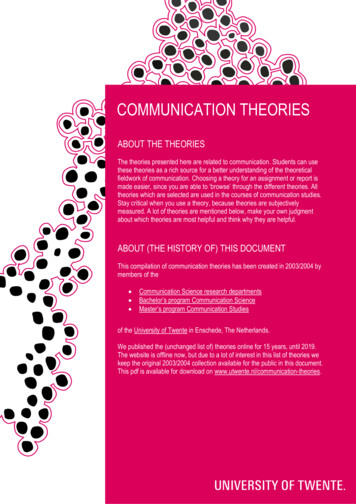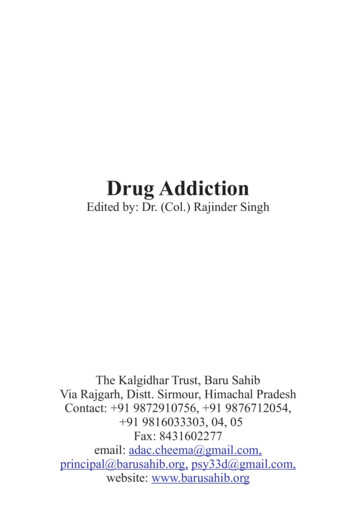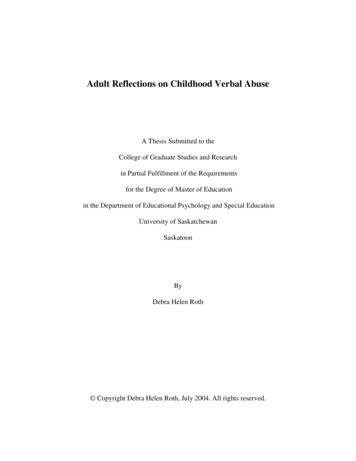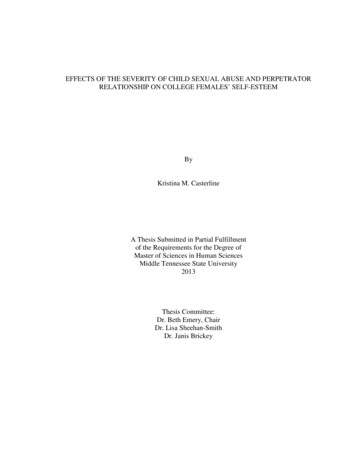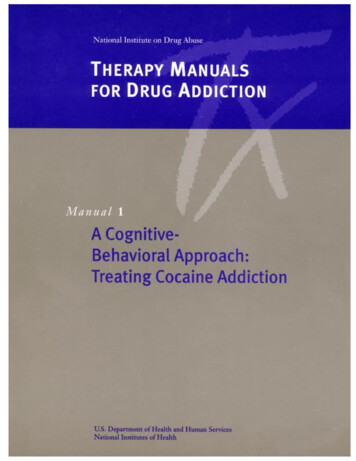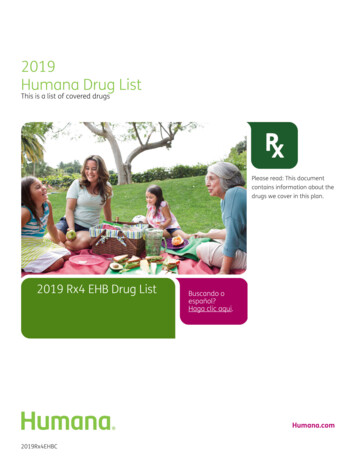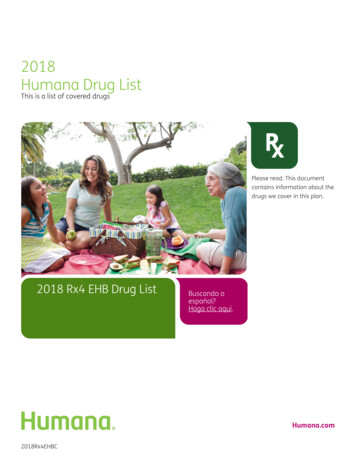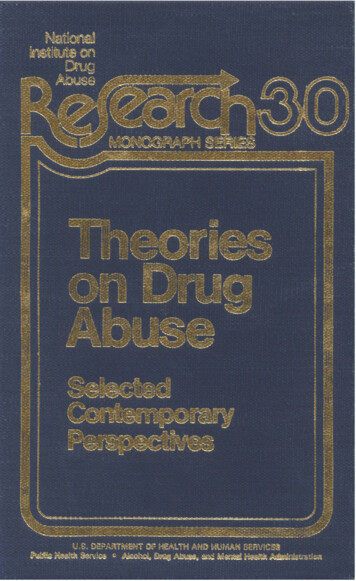
Transcription
THEORIES ONDRUG ABUSESelected ContemporaryPerspectivesEditors:DAN J. LETTIERI, Ph.D.MOLLIE SAYERSHELEN WALLENSTEIN PEARSONNIDA Research Monograph 30March 1980DEPARTMENT OF HEALTH AND HUMAN SERVICESPublic Health ServiceAlcohol, Drug Abuse, and Mental Health AdministrationNational Institute on Drug AbuseDivision of Research5600 Fishers LaneRockville, Maryland 20857For sale by the Superintendent of Documents, U.S. Government Printing OfficeWashington, D.C. 20402
The NIDA Research Monograph series is prepared by the Division of Research ofthe National Institute on Drug Abuse. Its primary objective is to provide critical reviews of research problem areas and techniques, the content of state-of-the-artconferences, integrative research reviews and significant original research. Itsdual publication emphasis is rapid and targeted dissemination to the scientificand professional community.Editorial Advisory BoardAvram Goldstein, M.D.Addiction Research FoundationPalo Alto, CaliforniaJerome Jaffe, M.D.College of Physicians and SurgeonsColumbia University, New YorkReese T. Jones, M.D.Langley Porter Neuropsychiatric lnstituteUniversity of CaliforniaSan Francisco, CaliforniaWilliam McGlothlin, Ph.D.Department of Psychology, UCLALos Angeles, CaliforniaJack Mendelson, M.D.Alcohol and Drug Abuse Research CenterHarvard Medical SchoolMcLean HospitalBelmont, MassachusettsHelen Nowlis, Ph.D.Office of Drug Education, DHEWWashington, D.C.Lee Robins, Ph.D.Washington University School of MedicineSt. Louis, MissouriNIDA Research Monograph seriesWilliam Pollin, M.D.DIRECTOR, NIDAMarvin Snyder, Ph.D.DIRECTOR, DIVISION OF RESEARCH, NIDARobert C. Petersen, Ph.D.EDITOR-IN-CHIEFEleanor W. WaldropMANAGING EDITORParklawn Building, 5600 Fishers Lane, Rockville, Maryland 20857
THEORIES ONDRUG ABUSESelected ContemporaryPerspectives
The National Institute on Drug Abuse has obtained permissionfrom the copyright holders to reproduce certain previouslypublished material as noted in the text. Further reproductionof this material is prohibited without specific permission ofthe copyright holders. All other material, except shortquoted passages from copyrighted sources, is in the publicdomain and may be used and reprinted without permission.Citation as to source is appreciated.The U.S. Government does not endorse or favor any specificcommercial product or commodity. Trade or proprietarynames appearing in this publication are used only becausethey are considered essential in the context of the studiesreported herein.Library of Congress catalog card number 80-600058DHHS publication number (ADM) 80-967Printed 1980NIDA Research Monographs are indexed in the Index Medicus.They are selectively included in the coverage of BiosciencesInformation Service, Chemical Abstracts, Psychological Abstracts,and Psychopharmacology Abstracts.Publication development services provided by METROTEC,Inc., under contract No. 271-79-3625 with the National Instituteon Drug Abuse.Cover art by Wendelin Astra Davidson, used with permission of the artist.iv
ContentsFOREWORDxixiiiA GUIDE TO THE VOLUMEPart 1THEORETICAL PERSPECTIVESAND OVERVIEWSTheories on One’s Relationship to SelfAN INTERACTIONAL APPROACHTO NARCOTIC ADDICTIONDavid P. Ausubel4THE CAP CONTROL THEORY OF DRUG ABUSESteven R. Gold8THE BAD-HABIT THEORY OF DRUG ABUSEDonald W. Goodwin12INTERACTIVE MODELS OF NONMEDICAL DRUG USERichard L. Gorsuch18AN EXISTENTIAL THEORY OF DRUG DEPENDENCEGeorge B. Greaves24AN EGO/SELF THEORY OF SUBSTANCE DEPENDENCE:A CONTEMPORARY PSYCHOANALYTIC PERSPECTIVEEdward J. Khantzian29A GENERAL THEORY OF ADDICTIONTO OPIATE-TYPE DRUGSAlfred R. Lindesmith34THEORY OF DRUG USEHarvey Milkman and William Frosch38v
CONTENTS (Continued)AN AVAILABILITY-PRONENESSTHEORY OF ILLICIT DRUG ABUSEReginald G. Smart46PERCEIVED EFFECTS OF SUBSTANCEUSE: A GENERAL THEORYGene M. Smith50A LIFE-THEME THEORY OF CHRONIC DRUG ABUSEJames V. Spotts and Franklin C. Shontz59DRUG USE AS A PROTECTIVE SYSTEMLeon Wurmser71Theories on One’s Relationship to OthersPSYCHOLOGICAL, SOCIAL, AND EPIDEMIOLOGICALFACTORS IN JUVENILE DRUG USElsidor Chein76INCOMPLETE MOURNING AND ADDICT/FAMILY TRANSACTIONS: A THEORYFOR UNDERSTANDING HEROIN ABUSESandra B. Coleman83THE SOCIAL DEVIANT AND INITIALADDICTION TO NARCOTICS AND ALCOHOLHarris E. Hill90FRAMEWORK FOR AN INTERACTIVE THEORY OF DRUG USEGeorge J. Huba, Joseph A. Wingard, and Peter M. Bentler95A SOCIAL-PSYCHOLOGICAL FRAMEWORKFOR STUDYING DRUG USERichard Jessor and Shirley Jessor102TOWARD A THEORY OF DRUG SUBCULTURESBruce D. Johnson110DEVELOPMENTAL STAGES INADOLESCENT DRUG INVOLVEMENTDenise B. Kandel120SELF-ESTEEM AND SELF-DEROGATIONTHEORY OF DRUG ABUSEHoward B. Kaplan128vi
CONTENTS (Continued)THE IOWA THEORY OF SUBSTANCE ABUSEAMONG HYPERACTIVE ADOLESCENTSJan Loney132REINFORCEMENT AND THE COMBINATION OF EFFECTS:SUMMARY OF A THEORY OF OPIATE ADDICTIONWilliam E. McAuliffe and Robert A. Gordon137ADDICTION TO AN EXPERIENCE: A SOCIALPSYCHOLOGICAL-PHARMACOLOGICALTHEORY OF ADDICTIONStanton Peele142A FAMILY THEORY OF DRUG ABUSEM. Duncan Stanton147SELF-ESTEEM THEORY OF DRUG ABUSER.A. Steffenhagen157BIOLOGICAL, PSYCHOGENIC, ANDSOCIOGENIC FACTORS IN DRUG DEPENDENCEW.K. van Dijk164A THEORY OF OPIOID DEPENDENCEAbraham Wikler174Theories on One’s Relationship to SocietyTHE SOCIAL BASES OF DRUG-INDUCED EXPERIENCESHoward S. Becker180DRUG ABUSE AS LEARNED BEHAVIORCalvin J. Frederick191PSYCHOSOCIAL THEORY OF DRUG ABUSE:A PSYCHODYNAMIC APPROACHHerbert Hendin195TOWARD A SOCIOLOGY OF DRUG USEIrving F. Lukoff201ACHIEVEMENT, ANXIETY, AND ADDICTIONRajendra K. Misra212THE NATURAL HISTORY OF DRUG ABUSELee N. Robins215vii
CONTENTS (Continued)A THEORY OF DRUG DEPENDENCE BASED ON ROLE,ACCESS TO, AND ATTITUDES TOWARD DRUGSCharles Winick225THE SOCIAL SETTING AS A CONTROLMECHANISM IN INTOXICANT USENorman E. Zinberg236Theories on One’s Relationship to NatureADDICTION TO PLEASURE: A BIOLOGICAL ANDSOCIAL-PSYCHOLOGICAL THEORY OF ADDICTIONNils Bejerot246METHADONE MAINTENANCE: ATHEORETICAL PERSPECTIVEVincent P. Dole and Marie E. Nyswander256A CHRONOBIOLOGICAL CONTROL THEORYMark Hochhauser262A BIOANTHROPOLOGICAL OVERVIEW OF ADDICTIONDoris F. Jonas and A. David Jonas269EMERGING CONCEPTS CONCERNING DRUG ABUSEWilliam R. Martin278SOMATOSENSORY AFFECTIONAL DEPRIVATION(SAD) THEORY OF DRUG AND ALCOHOL USEJames W. Prescott286A THEORY OF ALCOHOL AND DRUGABUSE: A GENETIC APPROACHMarc A. Schuckit297OPIATE RECEPTORS AND THEIRIMPLICATIONS FOR DRUG ADDICTIONEric J. Simon303viii
CONTENTS (Continued)Part 2THEORY COMPONENTSCONTENTS--PART 2310INITIATION313CONTINUATION336TRANSITION: USE TO ABUSE357CESSATION378RELAPSE402REFERENCES421ix
ForewordOne of the more striking aspects of drug research over the last fewyears is the relative upsurge of various models and theories explaining,wholly or in part, the problems of drug abuse. In fact, this rapidgrowth has signaled the need for a single, concise, and widely availablevolume which would allow interested researchers to discover the existence, diversity, convergence, and complexity of the array of contemporary explanatory perspectives.Undertaking the preparation of such a compendium was carefully considered. It was our intent to present as many theories as practicable,in an open, nonjudgmental, noncritical manner, and to allow eachtheorist to speak for his or her own theory. The volume contains 43theoretical perspectives representing the work of more than 50 theorists.I trust the reader will find this collection of ideas stimulating and willbe encouraged to generate future research aimed at hypothesis andtheory testing.Marvin Snyder, Ph.D.Director, Division of ResearchNational Institute on Drug Abusexi
A Guide to the VolumeOne of the early indications that a social problem research domain hascome of age is the quantity and quality of the theoretical explanationsfor it. Over the last several years interest in research on the problemsof drug dependence has grown dramatically. What is particularlystriking is that each of a wide array of scientific disciplines has exploredthe problem. Drug dependence is a complex contemporary socialproblem. Its complexity derives in part from the impact it has on theindividual user psychologically, socially, and biologically, and in partfrom its effects on society, law, economics, and politics.The primary intent of this volume is to present a representative selection of contemporary theoretical orientations and perspectives in thedrug abuse research field, derived from the social and biomedicalsciences. Among our secondary aims and intents were these: (1) toproduce a major reference volume for research scientists and otherinterested readers, (2) to afford theorists a forum in which to presenttheir views, and (3) to allow readers to compare and contrast thediverse range of theories on drug abuse.In designing this volume, it was necessary to assure that each contributing theorist would have sufficient latitude in style of presentation andtextual development, and yet that the reader would find comparablediscussions of formalized issues so that convergences and divergencesamong and between the theories could be easily discerned. The solutionto these apparently disparate aims was to divide the volume into twodistinct parts. Part 1 of the volume contains 43 separate theoreticaloverviews, one for each of the theories or perspectives. Here, thecontributors were given relatively free rein to present an overview oftheir positions. In contrast, the second part of the volume is purposefully highly structured.For practical purposes we needed a working definition for theories.The question became, “What is a theory of drug use/abuse, and whatare its components?” In general we viewed a theory as somethingwhich addressed at least several of the following topics: (1) whypeople begin taking drugs, (2) why people maintain their drug-takingbehaviors, (3) how or why drug-taking behavior escalates to abuse,(4) why or how people stop taking drugs, and (5) what accounts forthe restarting of the drug dependence behavior or cycle once stopped.The five chapters of part 2 refer to these five components of a theory,namely, Initiation, Continuation, Transition: Use to Abuse, Cessation,and Relapse. It was hoped that such an organizational frameworkwould facilitate the reader’s ability to compare and contrast the theories.xiii
In order to facilitate cross-theory comparisons even further, a seriesof guides has been included in the volume. Additionally, we developed,in conjunction with the authors, a set of shorthand or abbreviatedtheory titles. Guide 1 is a listing of all contributing theorists andtheir affiliations. The second guide is a classification of the theoriesinto four broad categories, theories on one’s relationship to self, toothers, to society, and to nature. A more specific classification of thetheories by academic discipline appears in guide 3.The most important of the guides is guide 4, Organization of theVolume. For each theory, this guide gives the pages on which theoverview can be found in part 1, and the page numbers of the corresponding theoretical components (if any) in part 2.Guide 5, Theory Boundaries, presents a concise, comparative summaryof each theory, including its drug focus; the age, sex, and ethnicityof the population to which the theory applies; and a listing of the keyvariables inherent in the theory.There are several ways to use this reference volume. One could ofcourse read it straight through. One could read a particular theoryoverview in part 1 immediately followed by the corresponding sectionsor components in part 2. Or one may wish to focus on a specifictheoretical component of interest in part 2 followed by selective readingof appropriate overview material in part 1. We hope that the volume’sspecialized format will encourage and facilitate its frequent use.Dan J. Lettieri, Ph.D.Chief, Psychosocial BranchDivision of ResearchNational Institute on Drug Abusexiv
GUIDE 1.—TheoristsRichard L. Gorsuch, Ph.D.Graduate School of PsychologyFuller Theological SeminaryPasadena, CaliforniaDavid P. Ausubel, M.D., Ph.D.Graduate School and University CenterCity University of New YorkandHochschule der BundeswehrMunich, West GermanyGeorge B. Greaves, Ph.D.Department of PsychologyGeorgia State UniversityAtlantaHoward S. Becker, Ph.D.Department of SociologyNorthwestern UniversityEvanston, IllinoisHerbert Hendin, M.D.Center for Psychosocial StudiesVeterans AdministrationFranklin Delano Roosevelt HospitalMontrose, New YorkandProfessor of PsychiatryNew York Medical CollegeValhallaNils Bejerot, M.D.Department of Social MedicineKarolinska InstituteStockholm, SwedenPeter M. Bentler, Ph.D.Department of PsychologyUniversity of California-Los AngelesHarris E. HiII, Ph.D. (retired)National lnstitute of Mental HealthAddiction Research CenterLexington, Kentuckylsidor Chein, Ph.D.Department of PsychologyResearch Center for Human RelationsNew York UniversityMark Hochhauser, Ph.D.Division of School Health EducationUniversity of MinnesotaMinneapolisSandra B. Coleman, Ph.D.Department of Mental Health SciencesHahnemann Medical College and HospitalandAchievement Through Counseling andTreatmentPhiladelphia, PennsylvaniaGeorge J. Huba, Ph.D.Department of PsychologyUniversity of California--Los AngelesRichard Jessor, Ph.D.Department of Psychology and Instituteof Behavioral ScienceUniversity of ColoradoBoulderVincent P. Dole, M.D.Rockefeller UniversityNew York CityCalvin J. Frederick, Ph.D.National Institute of Mental HealthandDepartment of PsychiatryThe George Washington UniversityWashington, D.C.Shirley Jessor, Ph.D.Department of Psychology and Institute ofBehavioral ScienceUniversity of ColoradoBoulderWilliam Frosch, M.D.Drug/Alcohol InstituteMetropolitan State CollegeDenver, ColoradoBruce D. Johnson, Ph.D.New York State Division of SubstanceAbuse ServicesNew York CitySteven R. Cold, Ph.D.Department of PsychologyWestern Carolina UniversityCullowhee, North CarolinaA. David Jonas, M.D.University of WurzburgGerman Federal RepublicDonald W. Goodwin, M.D.Department of PsychiatryUniversity of Kansas Medical CenterKansas City, KansasDoris F. Jonas, Ph.D.Fellow, Royal Anthropological Instituteof Great BritainLondonRobert A. Gordon. Ph.D.Department of Social RelationsJohns Hopkins UniversityBaltimore, MarylandDenise B. Kandel, Ph.D.School of Public Health andDepartment of PsychiatryColumbia UniversityNew York Cityxv
GUIDE 1. —Theorists—ContinuedMarc A. Schuckit, M.D.Department of PsychiatrySchool of MedicineUniversity of California, San DiegoLa JollaHoward B. Kaplan, Ph.D.Department of PsychiatryBaylor College of MedicineHouston, TexasEdward J. Khantzian, M.D.Department of PsychiatryHarvard Medical SchoolCambridge, MassachusettsFranklin C. Shontz, Ph.D.Department of PsychologyUniversity of KansasLawrenceAlfred R. Lindesmith, Ph.D.Department of SociologyIndiana UniversityBloomington, IndianaEric J. Simon, Ph.D.New York University Medical CenterNew York CityReginald G. Smart. Ph.D.Addiction Research FoundationToronto, Ontario, CanadaJan Loney, Ph.D.Department of PsychiatryThe University of IowaIowa CityGene M. Smith, Ph.D.Erich Llndemann Mental Health CenterHarvard Medical SchoolBoston, MassachusettsIrving F. Lukoff, Ph.D.Columbia UniversitySchool of Social WorkNew York CityJames V. Spotts, Ph.D.Greater Kansas City Mental Health FoundationKansas City, MissouriWilliam R. Martin, M.D.Department of PharmacologyAlbert B. Chandler Medical CenterUniversity of KentuckyLexingtonM. Duncan Stanton. Ph.D.Philadelphia Child Guidance ClinicVeterans Administration Drug DependenceTreatment CenterandUniversity of Pennsylvania School of MedicinePhiladelphiaWilliam E. McAuliffe, Ph.D.Department of Behavioral SciencesHarvard School of Public HealthBoston, MassachusettsR.A. Steffenhagen, Ph.D.Department of SociologyUniversity of VermontBurlingtonHarvey Milkman, Ph.D.Drug/Alcohol InsitituteMetropolitan State CollegeandDepartment of PsychiatryUniversity of Colorado Medical CenterDenverW.K. van Dijk, M.D.Department of PsychiatryPsychiatric University ClinicAcademisch Ziekenhuis GroningenGroningen, The NetherlandsRajendra K. Misra, D. Phil.Northeast Community Mental Health CenterEast Cleveland, OhioAbraham Wikler, M.D.Albert B. Chandler Medical CenterUniversity of KentuckyLexingtonMarie Nyswander, M.D.Rockefeller UniversityNew York CityJoseph A. Wingard, Ph.D.Department of PsychologyUniversity of California--Los AngelesStanton Peele, Ph.D.Department of Health EducationTeachers College at Columbia UniversityNew York CityCharles Winick, Ph.D.Department of SociologyThe City College of the City Universityof New YorkNew York CityLeon Wurmser, M.D.Alcohol and Drug Abuse ProgramSchool of MedicineUniversity of MarylandBaltimoreJames W. Prescott, Ph.D.Institute of Humanistic ScienceWest Bethesda, MarylandLee N. Robins, Ph.D.Department of PsychiatryWashington University School of MedicineSt. Louis, MissouriNorman Zinberg, M.D.Harvard Medical SchoolThe Cambridge HospitalCambridge, Massachusettsxvi
GUIDE 2.—Theory classificationTheory classification was in the main chosen by the authors and reflects the authors’ first choice of category.It is recognized that many of these theories could be classified in more than one category.--ED.1The choosing of this classification was somewhat arbitrary; other classifications would also have been appropriate.
GUIDE 2. —Theory1classification–ContinuedThe choosing of this classification was somewhat arbitrary; other classifications would also have been appropriate.
GUIDE 2. —Theory1classification–ContinuedThe choosing of this classification was somewhat arbitrary; other classifications would also have been appropriate.
GUIDE 3.—Disciplinary foci of the theories
GUIDE 3.—Disciplinary foci of the theories–Continued
GUIDE 3.—Disciplinary foci of the theories–Continued
GUIDE 3.—Disciplinary foci of the theories–Continued
GUIDE 4.—Organization of the volume
GUIDE 4.—Organization of the volume–Continued
GUIDE 4.—Organization of the volume–Continued
GUIDE 4.—Organization of the volume–Continued
GUIDE 4.—Organization of the volume–Continued
GUIDE 5.—Theory boundaries
GUIDE 5.—Theory boundaries–Continued
GUIDE 5.—Theory boundaries–Continued
GUIDE 5.—Theoryboundaries–Continued
GUIDE 5.—Theoryboundaries–Continued
GUIDE 5.—Theoryboundaries–Continued
GUIDE 5.—Theory boundaries–Continued
GUIDE 5.—Theoryboundaries–Continued
GUIDE 5.—Theory boundaries–Continued
GUIDE 5.—Theory boundaries–Continued
GUIDE 5.—Theory boundaries–Continued
GUIDE 5.—Theorybounderies–Continued
GUIDE 5.—Theory boundaries–Continued
PART 1THEORETICALPERSPECTIVESAND OVERVIEWS
THEORIES ONOne’sRelationshipto Self
An Interactional Approachto Narcotic AddictionDavid P. Ausubel, M.D., Ph.D.As in other fields of medicine and the behavioral sciences, an interactional approach to the etiology, epidemiology, psychopathology, andtreatment of narcotic addiction implies the operation of multiple causalitywithin the person, in the environment, and in the interaction betweenthem. One must consider both long-term predisposing factors andmore immediate precipitating factors.The most important precipitating factor in narcotic addiction is degreeof access to narcotic drugs. This factor, for example, explains inpart why narcotic addiction rates are higher in the urban slums thanin middle-class suburbs and why the incidence of narcotic addictionapproached the zero level during World War II when normal commercialchannels in the illicit narcotics trade were disrupted. Thus, no matterhow great the cultural attitudinal tolerance for addictive practices is,or how strong individual personality predispositions are, nobody canbecome addicted to narcotic drugs without access to them. Hence thelogic of a law enforcement component in prevention.The second most important predisposing factor in the etiology of narcotic addiction is the prevailing degree of attitudinal tolerance towardthe practice in the individual’s cultural, subcultural, racial, ethnic,and social class milieu. This factor explains differences in incidencerates between lower class and middle-class groups, between Europeans,Americans, and Orientals (except the Japanese), and between membersof the medical and allied health professions and other occupationalgroups (Ausubel 1961, 1962, 1966).The crucial and determinative predisposing factor, which, therefore,constitutes the most acceptable basis for the nosological categorizing ofnarcotic addicts, is the possession of those idiosyncratic or developmental personality traits for which narcotic drugs have adjustiveproperties. Thus it is obvious that narcotic drugs are more addictivethan, say, milk of magnesia, because their greater psychotropic effectshave adjustive value for these personality traits. Chief among theseeffects is euphoria, which is highly adjustive for inadequate personalities, i.e., motivationally immature individuals lacking in such criteriaof ego maturity as long-range goals, a sense of responsibility,4
self-reliance and initiative, volitional and executive independence,frustration tolerance, and the ability to defer the gratification ofimmediate hedonistic needs for the sake of achieving long-term goals(Ausubel 1947, 1948, 1952a,b, 1958,a,b, 1961, 1962, 1966, 1980a,b;Ausubel and Ausubel 1963; Ausubel and Spalding 1956). Severalclinical studies of hard-core addict populations (e.g., Ausubel 1947;Dai 1937; Pescor 1939; Research Center for Human Relations 1957a;Zimmering et al. 1951, 1952) have shown that most chronic narcoticaddicts fall in this diagnostic category. Other studies (Ausubel 1947;Chein et al. 1964; Dai 1937; Research Center for Human Relations1957a) have uncovered in the life histories of such addicts those typesof parent-child relationships, i.e., overpermissive (underdominating),overprotecting, and overdominating parents, that tend to foster thedevelopment of the inadequate personality syndrome.Contributory factors in the development of this syndrome are probablygenic (polygenic) in origin and are undoubtedly fostered by lowersocial-class membership, particularly in families that have been onwelfare for one or more generations. Most of such latter youth, ofcourse, are not motivationally inadequate and tend to be sporadicnarcotic users who do not become either physiologically or psychologically dependent upon the drugs in question. Epidemiological studiesby the New York University Research Center for Human Relations(1957a) have developed various behavioral, familial, and socioeconomiccriteria for differentiating between these two groups.Because of these euphoric properties of narcotic drugs effected throughdepression of the self-critical faculty and the positive pleasure of the“rush,” addicts receive an immediate, unearned form of gratificationand ego enhancement. These same euphoric properties are also obviously adjustive for persons with histories of recurrent reactive depression. Recent studies with endogenously produced opiates, i.e.,endorphins and enkephalins (Costa and Trabucchi 1978; Goldstein1976c; Snyder 1977), suggest that in some instances deficiencies inthe production of the substances that contribute to normal optimism inthe face of life’s vicissitudes (and hence have evolutionary survivalvalue for the species) contribute toward the incidence of narcoticaddiction. A recent study of psychiatrically disabled, treated narcoticaddicts (Ausubel 1980a) shows that lower middle- and working-classaddicts tend almost exclusively to develop severe anxiety states andreactive depressions when under psychological or environmental stress,whereas addicts from urban slum welfare backgrounds almost invariablydevelop schizophrenic symptoms under similar circumstances. Thisdifference in pathological outcome probably reflects some insidiousinternalization of mature motivational traits by the lower middle- andworking-class addicts despite the overt domination of the personalitytraits of the inadequate personality.Another psychopharmacological effect of opiates, namely, sedation orrelief of anxiety, probably accounts for the small minority of narcoticaddicts who suffer from disabling neurotic anxiety. Such individuals,particularly members of the medical and allied health professions,typically take small, well-controlled doses of morphine subcutaneously(rather than large doses of heroin intravenously) for their sedativerather than their euphoric properties. Typically their addiction is welldisguised and seldom recognizable (Jaffe 1970a,b).W idespread sporadic use of heroin in adolescents with relatively normalpersonality structures is generally reflective of the aggressive, antiadult5
orientation characterizing adolescents in our culture. Here the personality predisposition is developmental rather than idiosyncratic.Apart from the aforementioned affirmative clinical evidence supportingthe existence of personality predispositions for which narcotic drugshave adjustive value, the very logic of this proposition itself is compelling. How else could one explain why, in a given urban slumneighborhood with uniform access to narcotic drugs and uniform subcultural or ethnic attitudinal tolerance for narcotic addiction, the vastmajority of adolescents become only sporadic, nonaddicted drug users,whereas a relatively small minority become chronically addicted?A separate nosological category of addiction can probably be made toinclude minority-group youths with normal or even better-than-averagemotivational maturity who use narcotic drugs chronically for limitedperiods of time because they perceive the odds of achieving any ordinarydegree of academic or vocational success as so overwhelmingly stackedagainst them.Finally, a very small minority of narcotic addicts may be classified aspsychopathic or sociopathic personalities (Kolb 1925a,b). Drug addiction, insofar as it is regarded as a disreputable or socially disapprovedhabit, obviously has nonspecific adjustive value for such persons;however, it provides only one of many available nonspecific outlets foraggression or “acting out” behavior against society. Such addictstend to commit the violent, remorseless crimes that are popularly anderroneously associated in the public mind with drug addicts generally.Actually, of course, the sedative action of narcotics tends to in!hibitviolence of any kind unless addicts are particularly desperate for theirnext “fix.”For the most part, except for the relatively rare psychopathic addict,most chronic addicts engage in nonviolent, remunerative crimes primarilyto support their habits, e.g., “pushing,” “con” games, shoplifting,check forgery, “paperhanging,” fraudulent magazine subscriptions,etc. (Chein et al. 1964; Kolb 1925a). The percentage of addictsinvolved in preaddiction delinquency is generally lower than that ofnonaddict narcotic users who are members of delinquent gangs inurban slum areas (Ausubel 1958a,b; Research Center for Human Relations 1957a). In any case, delinquent addicts tend to be involved inmore remunerative delinquencies directed toward satisfying their drughabits than in the more violent, predatory gang activities and “rumbles”(or gang warfare) (Research Center for Human Relations 1957a).SPECIAL POPULATIONSALCOHOLISM AND OTHER DRUGABUSE IN NARCOTIC ADDICTSAddicts in methadone maintenance programs, when deprived of theirheroin-induced euphoria, turn to the euphoria-inducing properties ofalcohol, large doses of barbiturates, amphetamines, benzodiazepines,and amitriptyline. Sometimes overdosage of these drugs leads to accidental or, in reactive depressives, to deliberate suicide. Reference hasalready been made to the relationship between addiction, on the onehand, and psychopathology and criminality, on the other.6
It is generally agreed that most addicts have a preferred drug that ismost adjustive for their particular idiosyncratic or developmental personality defects and that they use other drugs only when deprived ofaccess to their drug of choice. Heroin and marijuana, for example,each have their own separate constituencies based on their distinctivepsychopharmacological effects. The use of marijuana does not predispose an individual to heroin use except insofar as it may “break theice” for more dangerous drug use. Narcotic addicts tend in general tohave a history of prior marijuana use because the latter drug is moreaccessible, cheaper, and considered less dangerous and less sociallydisapproved. The connection between the two types of drugs is notcausal: The converse of this proposition is not true, i.e., the vastmajority of marijuana users exhibit no later history of heroin abuse(Robins et al. 1970).PHYSICIAN ADDICTSClinical experience with large numbers of physician addicts at theLexington Hospital indicates that there are essentially two differentkinds of underlying predispositions: (1) the intelligent, overdominatedinadequate personality who was forced into the profession by parentsseeking vicarious ego enhancement, and who later rejects the goals ofadult maturity as a measure of revenge against parental overdominationas soon as the parent dies or ceases to be autocratic, and (2) theanxiety neurotic who uses small, controlled doses of morphine subcutaneously to relieve anxiety rather than to obtain euphoria. These aretypically highly achievement-oriented persons who seek in unusualaccomplishment the ego enhancement and sense of intrinsic self-esteemnever possessed because their parents either rejected them or failed toaccept them for themselves (perceiving them solely as sources forvicarious ego enhancement).7
The CAP Control Theoryof Drug AbuseSteven R. Gold, Ph.D.W ith our current incomplete understanding of drug use and abuse, theappropriate function of any theoretical model may be to stimulate newwork in the area. The aim of this paper is to describe a theory o
discussions of formalized issues so that convergences and divergences among and between the theories could be easily discerned. The solution to these apparently disparate aims was to divide the volume into two distinct parts. Part 1 of the volume contains 43 separate theoretical overviews, one for each of the theories or perspectives. Here, the
